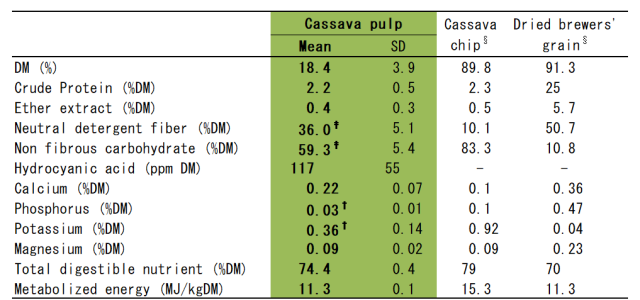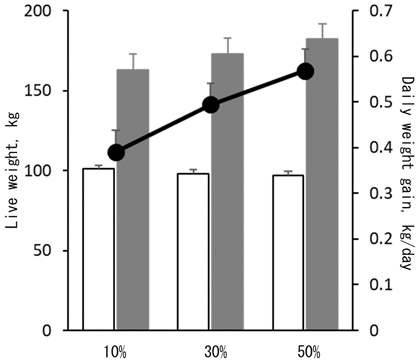Cassava pulp is suitable as beef cattle feed and shows less variation in chemical contents among seasons and factories
Description
Cassava (Manihot esculenta) is one of Thailand’s major crops, with about half of domestic production coming from the northeastern region. Cassava pulp, the major waste produced from starch factories, is considered a nutritious feed for cattle because of its high starch and fiber contents. To promote cassava pulp utilization as cattle feed, variations in chemical composition among seasons and starch factories, energy value, and performance of beef cattle fed with cassava pulp were investigated.
Cassava pulp samples were collected in each season -- the rainy season (mid-May to mid-October), summer (mid-October to mid-February), and winter (mid-February to mid-May) -- from four starch factories in northeastern Thailand. Significant variations in phosphorus and potassium contents were found among factories (Table 1). Constant variation in any of the chemical components was not found among the three seasons. Crude protein content of cassava pulp was close to that of cassava chip. Energy values, obtained from feeding trial using four Thai native cattle fed basal diet or basal diet with cassava pulp at maintenance level, were close to that of dried brewers' grain.
Eighteen yearling Thai native cattle were allocated to one of three dietary treatments and fed ad libitum (i.e., as much as desired) for 5 months in a randomized complete block design. Three dietary treatments using different proportions of cassava pulp (10, 30 and 50% as dry matter) instead of rice straw as a base in a fermented total mixed ration were applied (Table 2). The diets were formulated to contain 10% crude protein and exceed their energy requirement. Metabolized energy content and daily weight gain increased with increasing cassava pulp content (Fig. 1).
These results provide useful information on beef cattle rearing using cassava pulp and contribute in promoting the utilization of waste (cassava pulp) from cassava factories. Cassava pulp should be used as soon as possible or kept under anaerobic condition because of its low aerobic stability. The physical effective fiber content and nutrient requirements must be noted when diets are formulated with a high cassava pulp ratio.
Figure, table
-
Table 1. Chemical composition and energy values of cassava pulp, cassava chip and dried brewers' grain
DM:dry matter, †significant difference among factories (P<0.05)、‡interaction between factory and season (P<0.05), §Data obtained from Nutrient Requirements of Beef Cattle in Indochinese Peninsula (2010)
-
Table 2. Feed formula, chemical composition and energy value of fermented total mixed ration containing 10, 30 and 50% of cassava pulp (dry matter basis) Cassava pulp ratio Low Medium High Feed formula (DM basis) Cassava pulp 10.0 30.0 50.0 Rice straw 50.0 30.0 10.0 Palm Kernel meal 23.5 23.5 23.5 Soybean meal 5.0 5.0 5.0 Rice bran 10.0 10.0 10.0 Urea 0.5 0.5 0.5 Vitamin & mineral premix 1.0 1.0 1.0 Chemical composition (%DM) Crude protein 9.9 9.7 9.7 Ether extract 5.9 5.9 5.9 Neutral detergent fiber 63.2 53.6 45.2 Non fibrous carohydrate 10.5 22.9 33.7 Metabolized energy(MJ/kgDM) 9.6 11.4 12.4 DM: dry matter
-
Fig. 1. Initial (□) and final (■) live weight, and daily weight gain (●) of Thai native cattle fed fermented total mixed ration containing 10, 30 and 50% of cassava pulp (dry matter basis; Low, Medium, and High, respectively).
Daily weight gain linearly increased with increasing cassava pulp inclusion (P<0.05).
- Affiliation
-
Japan International Research Center for Agricultural Sciences Crop, Livestock and Environment Division
- Research project
- Program name
- Term of research
-
FY2018 (FY2015-FY2018)
- Responsible researcher
-
Suzuki Tomoyuki ( Institute of Livestock and Grassland Science, NARO )
ORCID ID0000-0002-5313-7647KAKEN Researcher No.: 70391175Kaeokliang Ornvimol ( Department of Livestock Development, Ruminants Feeding Standard Research and Development Center, Thailand )
Angthong Wanna ( Department of Livestock Development, Ruminants Feeding Standard Research and Development Center, Thailand )
Narmseelee Ramphrai ( Department of Livestock Development, Ruminants Feeding Standard Research and Development Center, Thailand )
Kawashima Tomoyuki ( University of Miyazaki )
ORCID ID0000-0002-6132-9470KAKEN Researcher No.: 10355068Kongphitee Kanokwan ( Khon Kaen University )
ORCID ID0000-0003-4220-2754Gunha Thidarat ( Khon Kaen University )
ORCID ID0000-0001-6885-6903Sommart Kritapon ( Khon Kaen University )
ORCID ID0000-0002-6947-412XPhonbumrung Thamrongsak ( Bureau of Animal Nutrition Development, Department of Livestock Development, Thailand )
ORCID ID0000-0001-7853-5417 - ほか
- Publication, etc.
-
https://doi.org/10.1111/asj.13039
Keaokliang O et al. (2018) Animal Science Journal, 89:1120-1128
https://doi.org/10.5713/ajas.17.0759Kongphitee K et al. (2018) Asian-Australas. J. Anim. Sci., 31:1431-1441
- Japanese PDF
-
2018_A02_ja_2401112rev.pdf346.34 KB
- English PDF
-
2018_A02_en_240112rev.pdf351.35 KB
- Poster PDF
-
2018_A02_poster.pdf266.01 KB


